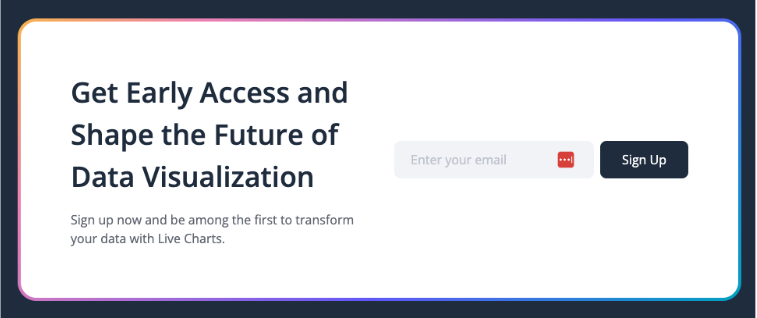Launching a successful product in a competitive market requires more initial groundwork than a brilliant idea.
Both startups and enterprises need to understand their potential in the market before investing in developing a final product. Building even the simplest but best-quality MVP will take you at least 6 sprints (12 weeks). Hiring a team to do this will cost at least $35k. However, you can save close to 70% of this initial investment by spending less on other tools first. This is our recommendation to startup founders: Where to start and how to explain your idea to potential users and investors.
Tools to pitch and validate your idea before MVP
1. Prepare an idea explanation email (free)
You can write down your idea in an email and send it to potential users. It is better if they are from the field, such as salespeople, support teams, or anyone who may potentially benefit from your solutions. You may reach out to your friends, but we recommend connecting with people you do not know yet as well. Nowadays, a tool like LinkedIn offers endless possibilities for connecting with other professionals.
At this stage, your audience will provide you with other solutions they use or some ideas or problems they really have. This test may take you 2-3 weeks, as people will need some time to reply. You can always set up a follow-up call to clarify some questions and talk to potential users. You can always prepare a brief presentation, which will help you tell a story about your solution.
2. Product Brief Presentation ($250)
While you can create nice text and add pictures by yourself, a visually appealing and well-structured presentation can make a significant difference. While you can certainly design a presentation yourself, consider hiring a professional graphic designer. In LaSoft, we allocate around $250 for design, recognizing the importance of maintaining a consistent and professional brand image.
If you plan to work with professionals, especially from the corporate world, a nice presentation will be a door opener, and a bad one may kill their desire to talk to you. Good presentation demonstrates your attention to detail and commitment to quality. So I recommend “making a cool presentation with good design if you want people to take you seriously.” It will take a bit longer, but it will be a powerful icebreaker.
3. Landing page ($2,000)
While a good explanatory email and idea presentation will help you talk to people from your circles, a landing page opens new possibilities. We usually go so far only if we have 5-10 solid positive feedbacks on your email and presentation. A good quality rule applies here as well. With a landing page, you may talk to people you do not know, using Ad Tools like Google Ads, for example. Yes, you do not have a tool yet, but you can always ask people to leave their email if they are interested in your idea. A captivating landing page will generate excitement and anticipation around your product.
Please see the example below.

We recommend spending not more than $1,000 on a paid campaign. This should generate 500-1000 visitors, and if everything works well, close to 5% of them will leave their email. This will be a good sign for you.
4. Explainer video ($250-$500)
Today, videos are highly engaging and effective way to communicate your idea. You can use the video to explain what problem you are trying to solve and how this may benefit the user. This will help your audience to visualize the benefits and understand the value proposition. It is better if you have an animation or some UI/UX designs ready, it will help you to illustrate your solutions and make a point. Here you can see an example of an explainer video: LiveСharts: The charts order process, the first version;
5. The Most Important Skill During the Product Validation
Active sales and meetings with potential users are the most important activities during the product validation stage. You need someone who can identify ICP, create outreach campaigns, persuade potential clients to attend meetings, conduct effective demos and interviews, and make informed judgments about market conditions and product-market fit. And this is the more entrepreneurial side of the game, not the technical.
6. Prototype Presentation ($3,500)
Let’s assume all previous methods generated initial interest in your idea or solution. A good signal is when at least 20% of the people you contact are interested in meeting and seeing the solutions demo. This means that the problem is there. Now you can use this opportunity to invite your potential clients during the co-creation process, showing them the solution prototype. Usually, we spend close to 100 hours to make a solution prototype, which costs us close to $3,500. At LaSoft, we can also help you implement the solution prototype using our Blitz UI/UX Design offer, which is specifically designed for startups in the validation stage.
Nowadays, many startup founders create their prototypes with Figma or Lovable, and the reason is simple: making changes to the prototype while the market is not yet validated will cost you much less than making changes to an already developed system.
Summary
So, you can validate your idea of spending less than $5,000. But at this stage, you will validate if there is a problem in the market and if people are looking for possible solutions. You will see this using the following KPIs:
- The number of beta users ready to test the solutions through the landing page, with 50 filled-in forms per 1,000 visits through the Google Ads campaign, is a good signal.
- The number of people who are ready to meet and see the solutions through an email outreach campaign. A 20% positive response rate is a good signal.
- Feedback on the prototype of the solution. You need to rely more on the feedback you get while showing the solutions prototype presentation. This is not a 100% quantitative metric, so you must rely more on the feedback you get during the interview.
But you have limitations here, and you won’t be able to validate whether people will be ready to pay for the solution at this stage. Sometimes, they say they will, but you can never be sure before they do. To validate pricing and potential users’ readiness to pay, you will need to provide a value, and this is possible only if you have at least a Concierge MVP in place. So, I will give some insights on Concierge MVPs in my next article.


